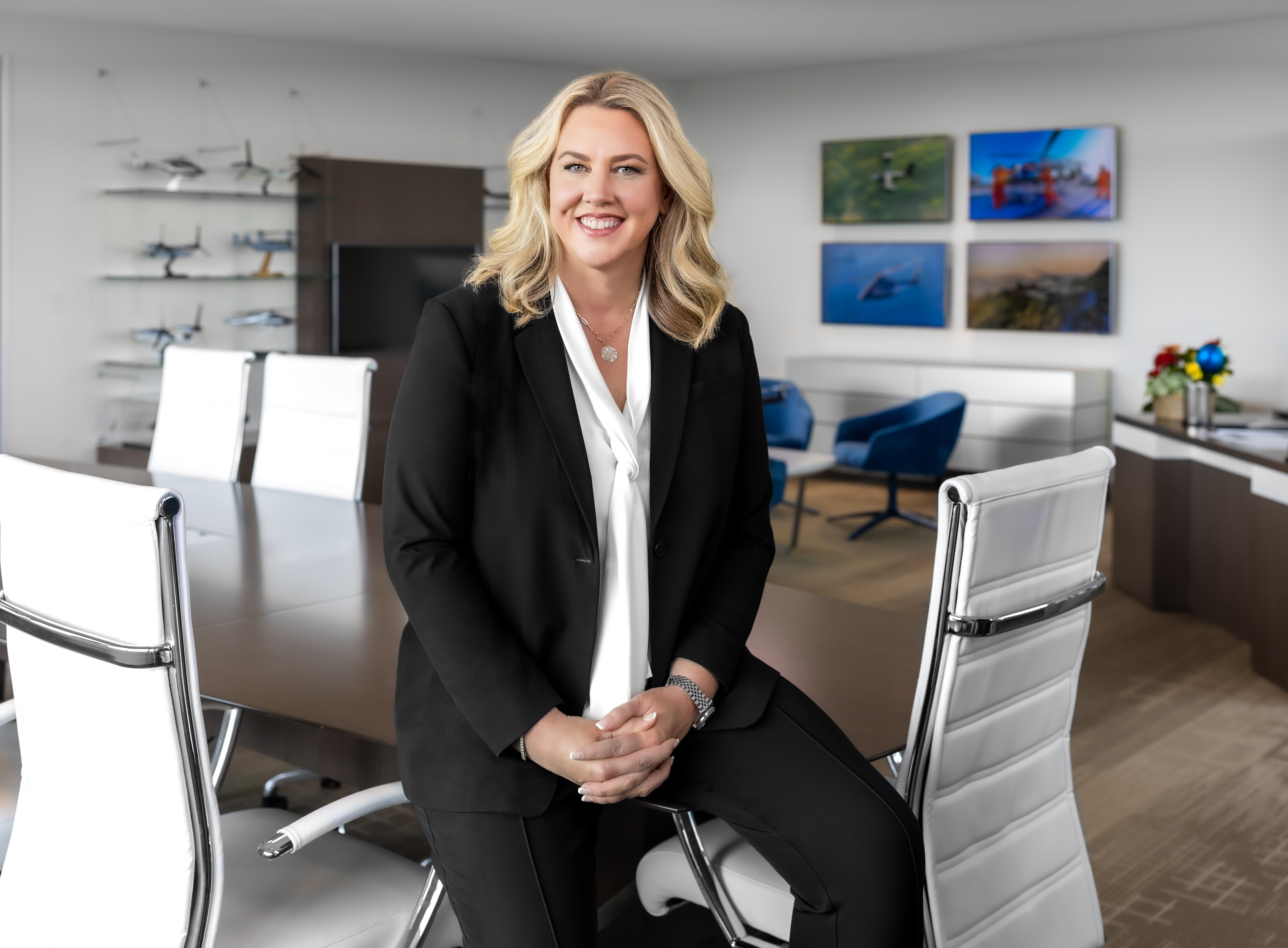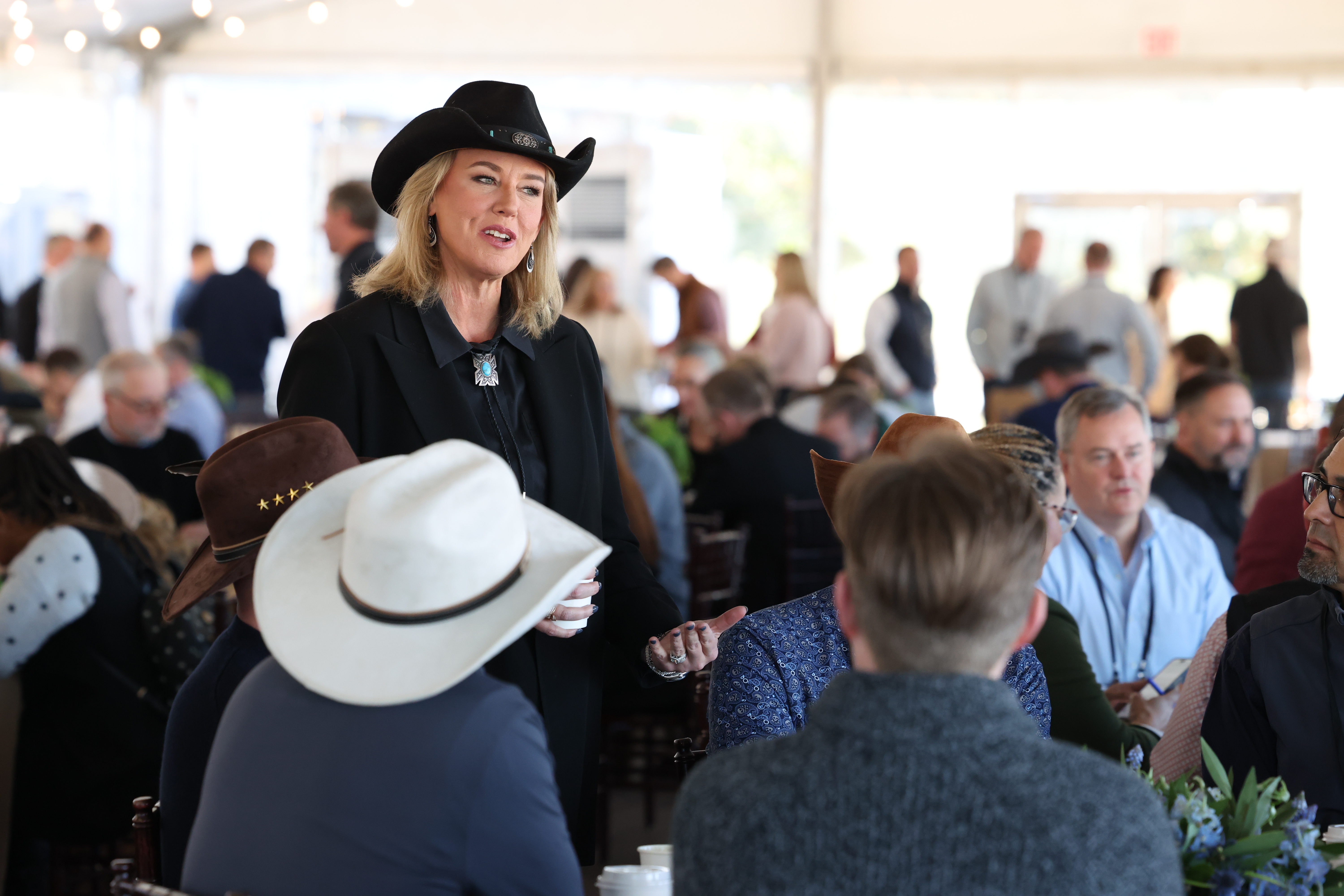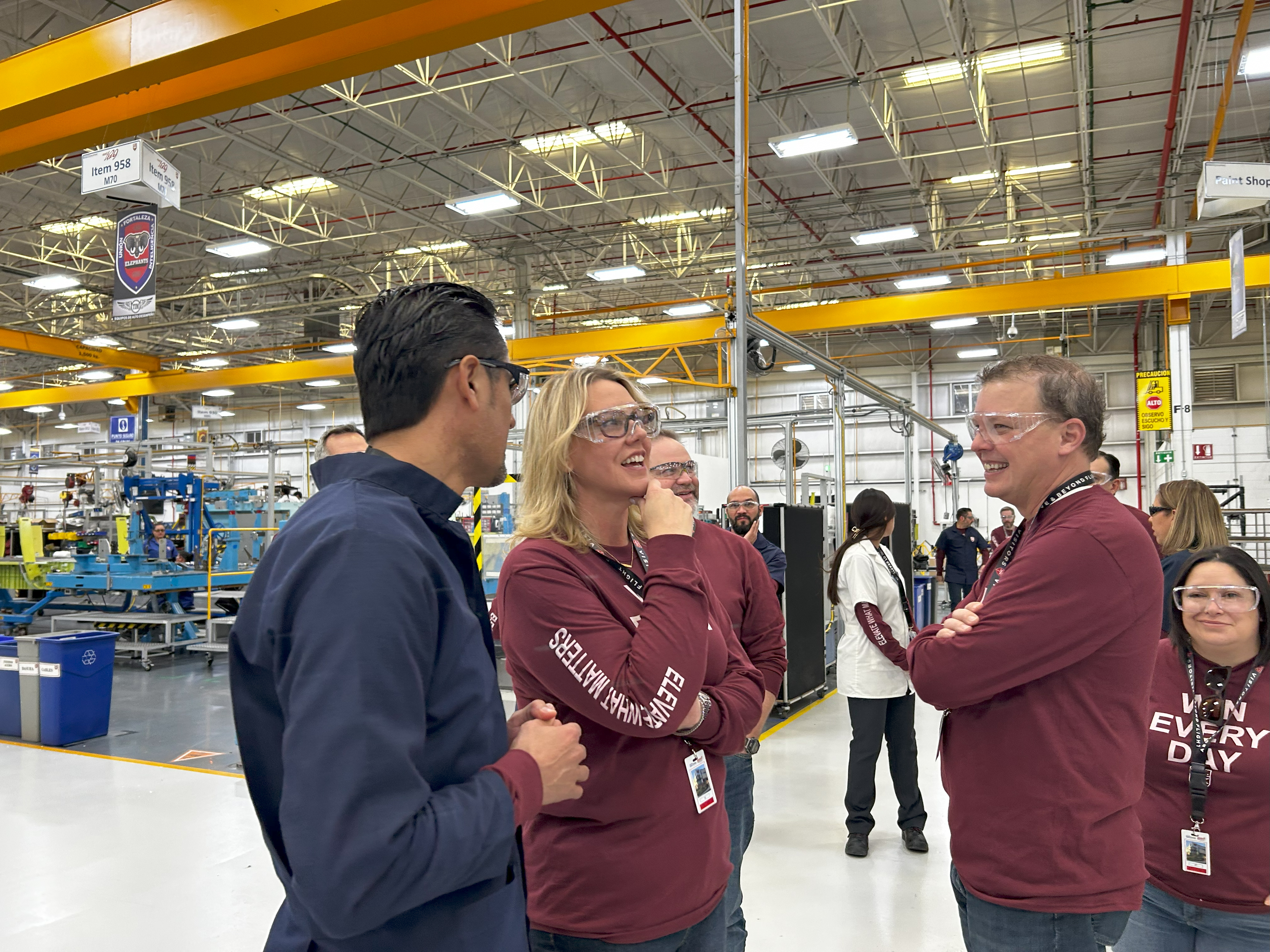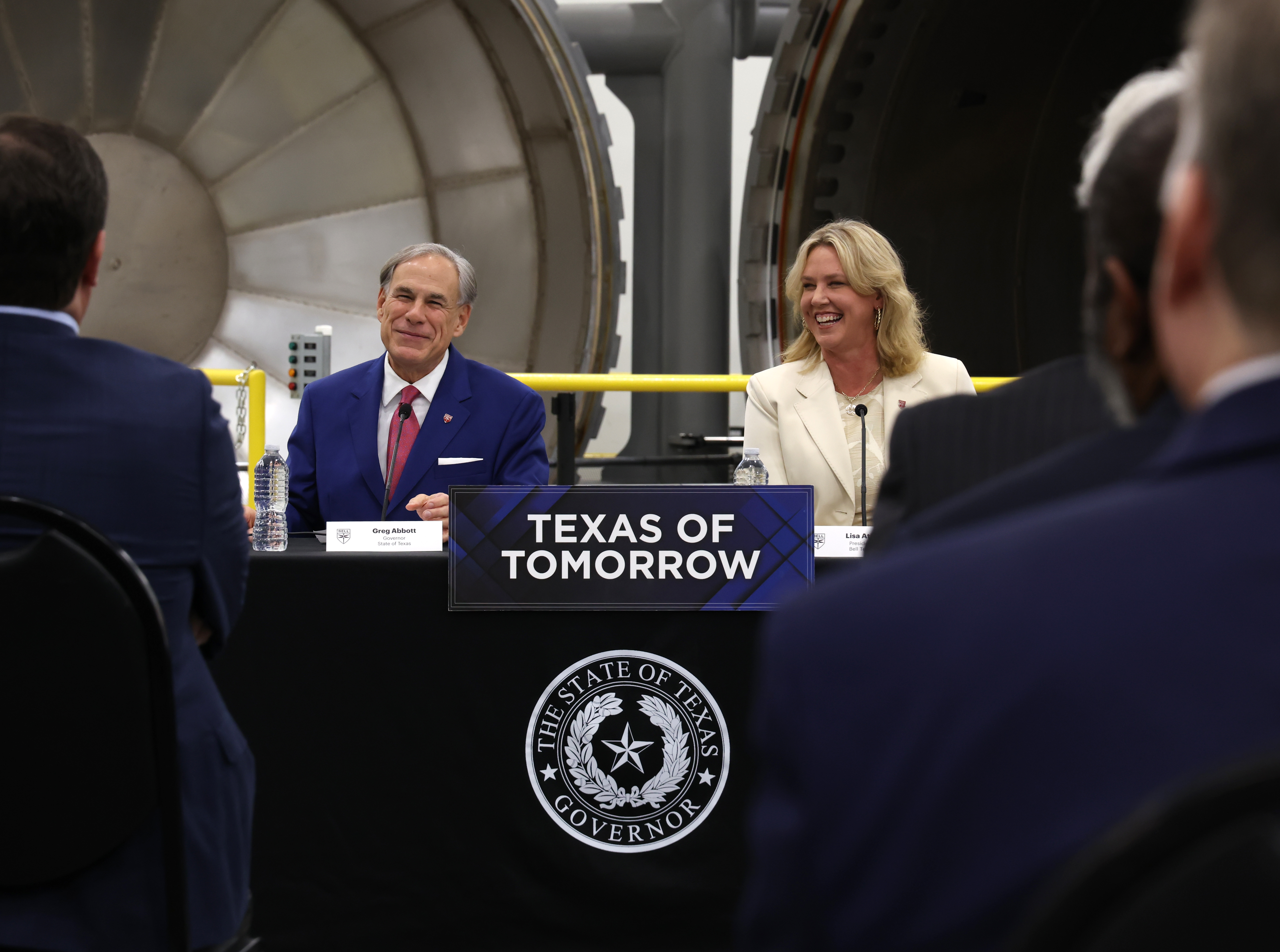From the
Tilton Hilton
to Bell CEO

Lisa Atherton ’96 remembers clinging to the fifth-level edge of the Tilton Hilton obstacle on Jacks Valley’s infamous confidence course, gripping the platform before flipping her body over the side, trusting that her fellow basic cadets would catch her as she fell. For someone with a severe fear of edges — not heights, but edges — the barrier seemed insurmountable.
“To this day, I remember the fear,” Atherton says. “Sometimes, you’ve got to take the leap and trust that you’ve got a team that’s going to support you on the other side.”
Thirty-three years later, that philosophy of calculated risk-taking and trust propels Atherton as president and CEO of Bell Textron, an 8,500-employee aerospace company manufacturing and delivering helicopters and vertical lift aircraft to military and commercial customers around the world.
ADAPTING THROUGH ADVERSITY

Atherton’s journey to the C-suite began on Florida basketball courts; the sport created a connection with her father and led to multiple scholarship offers.
A torn knee ligament her senior year of high school threatened to derail those athletic dreams.
“After I tore my ACL, the Academy still pursued me,” she says.
Then-women’s basketball head coach Marti Gasser advocated for Atherton as she underwent ACL reconstruction, but a second tear during her four-degree year for the Falcons ended her playing career.
Atherton focused on academics, changing majors from aerospace engineering to human factors to legal studies.
Today, Atherton continues her connection to the Academy, serving on the Air Force Academy Athletic Corporation board. The role keeps her tied to the institution that shaped her leadership foundation.
“I started off saying I was going to be an astro engineer. It’s probably because that was the first letter [of the alphabet] that came through,” she jokes. “I was going through the human factors engineering curriculum, and then had an experience where I was like, ‘You know, I think I want to go be a lawyer; join the JAG.’ So, I switched to legal studies.”
The Academy experience taught Atherton lessons that continue to shape her leadership philosophy.
“Those four years forged in me resilience and grit that has allowed me to face things head on,” she reflects. “That time and experience taught me that I can do anything.”
The constant balancing act required at the Academy — academics, military training, athletics and leadership roles — proved invaluable preparation for Atherton’s future.
“Learning those skills early benefited me in my life later on,” she says. For instance, she says the early time-management training she got at USAFA has helped her navigate one of the most persistent challenges facing leaders today: work-life integration.
Atherton rejects the notion of perfect balance. Instead, she advocates for thoughtful integration of professional and personal responsibilities, recognizing that different aspects of life require varying levels of attention at different times.
Her approach emphasizes being fully present wherever duty calls, whether at a child’s T-ball game or during a critical proposal deadline.
“If you stay focused and are present when your kid needs you, or when your spouse needs you, they’re going to give you the grace you need to be present in the workspace.”
MISSION BEYOND UNIFORM
After commissioning, Atherton spent a year at the Academy’s Center for Character and Leadership Development helping create sexual assault awareness and prevention policies.
“We needed to really incent the rest of the Cadet Wing to when they see something, say something, to feel confident in saying, ‘Hey, I don’t agree with some of this,’” she recalls.
The team established a cadet-run hotline providing confidential support, recognizing that victims need comprehensive care beyond just legal recourse.
“Our findings were that you needed to take care of the whole person,” she says. “You needed to get the medical help or psychological help.”
Atherton’s second assignment was as a contracts officer at Langley Air Force Base, Virginia.
She then transitioned to civilian service, working at Air Combat Command’s directorate of requirements for eight years during the critical post-9/11 period, shaping how the Air Force prepared for new combat realities.
Her government contracting experience caught the attention of Textron.
She joined the company’s weapons division in 2006 while pregnant with her son, Hayden.
Her husband stayed at home with their son, enabling Atherton to focus on increasingly demanding roles.
“I was able to come in and help Textron understand how the government budgeted,” she says.
The company took what she calls a “chance” in putting a new mother in a business development role requiring global travel.
“They didn’t have a lot of brand-new mothers running around the world doing business development,” she notes. “They had faith and belief in me, and I’ve been very loyal to them ever since.”
TAKING THE CONTROLS

A chance meeting with Mitch Snyder, an executive at Bell — a subsidiary of Textron — during an Air Force charity ball ultimately led to her transition to Bell’s Fort Worth, Texas-based operations.
Since joining the Textron organization 18 years ago, Atherton has held multiple leadership positions, including her self-described dream job as V-22 Osprey program manager.
She assumed the president and CEO role at Bell in 2023, leading a company that delivers nearly 200 commercial aircraft annually alongside dozens of military airframes.
What does Atherton most enjoy about leading Bell? “The people,” she responds immediately. “We’ve got the best engineers on the planet that are doing rotorcraft, vertical lift, but that then translates to these amazing groups of folks that are out there on the factory floor, taking those ideas and making them real and delivering them out to our customers.”
She says the lifesaving nature of Bell’s mission drives her daily.
“The majority of what helicopters and vertical lift do is go to areas that traditional aircraft can’t get to,” she says. “A car accident that you have to get help to fast, a critical heart transplant, someone lost at sea needing rescue, a military insertion or a rescue out of an embassy.”
She adds, “The things that we do in vertical lift for the people that we support is something that no one else can do. The ability to get the chance to do that and be a part of this network of folks gets me fired up every day.”

LEADERSHIP IN FLIGHT
on accountability and servant leadership.
“I am all about the team,” she says. “My personal philosophy is strongly around accountability and grit. It is strongly around doing what you say you’re going to do.”
This commitment matters because lives depend on Bell’s products.
“They don’t have the time for us to do it wrong,” Atherton says. “They don’t have the time for us to make mistakes. They need those parts. They need those helicopters. They need those vertical tilt rotors. They need them right away, on time, every time.”
But she emphasizes that accountability requires an empathetic balance.
“I also believe in being a servant leader,” she says. “It’s about putting others first.”
She seeks leaders who elevate others.
“I look for the people who are trying to make others successful because I know they’re actually the best leaders in the room, because they’re focused on helping others do well,” she says. “And if that’s what they’re doing, others want to work with them. Others want to be on their team.”
She champions trust-based leadership, describing herself as someone who gives trust rather than requiring others to earn it.
This approach reflects values forged during her Academy years and subsequent Air Force career.
The Air Force core values remain central to her approach, particularly “Integrity First.”
“It takes a second to lose trust if you don’t hold to your integrity,” she notes.
Bell has adopted a philosophy of “win every day,” which Atherton connects to her Academy experience.
“Whatever that task is, whatever it is that you set out that day to do, whether that is to get to your kid’s baseball game or get your engineering drawings released, or present the briefing out to corporate — whatever that is, crush it that day,” she says. “And all these little micro wins add up to really big wins overall.”
Failures, she says, become learning opportunities through structured reflection.
“Even from when Hayden was a little kid, I would say, ‘What are the three things you did well today, [and] what are three things you didn’t do well today?’” she says. “I do this with my team at the end of every year. ‘What are the three ups [and] the three downs of your year? And how do we build on this and how do we correct?’”
VERTICAL LIFT LEGACY
Under Atherton’s leadership, Bell continues to push the boundaries of vertical lift technology.
“We stand on the shoulders of giants,” Atherton says of Bell’s iconic legacy. “The folks that had the crazy idea of beating physics into submission, we’re forever indebted.”
She continues, “I think there’s a metric that says 82% of the missions flown vertically in the Vietnam era were Bell helicopters.”
Many early Academy graduates flew the original Huey — the Bell UH-1 Iroquois — during the Vietnam War, establishing a legacy that continues to this day.
The platform’s endurance is evident in its continued military service.
“The Marines are still flying versions of the Bell Huey family, with letters Yankee and Zulu,” Atherton explains. “We’ve exhausted all the letters.”
These modern variants are the Bell AH-1Z Viper and UH-1Y Venom.
For Atherton, the Huey evokes personal Academy memories.
During a survival training exercise her three-degree year at Jacks Valley, cadets vectored the helicopter to landing zones.
“I remember trying to call it in and I think I missed my mark all the time. Right! No, left! I mean right!” Atherton remembers.
Building on decades of rotorcraft excellence, Atherton reports that Bell has set its sights on transforming military aviation with its next-generation tiltrotor technology.
The Bell V-280 Valor represents the company’s most ambitious project, offering the Army an aircraft that flies twice as far and twice as fast as current helicopters.
The Army selected the V-280 Valor as the replacement for its Sikorsky UH-60 Black Hawk helicopter, finalizing a potential 30-year, $100 billion contract in April 2023.
This replacement is part of the Army’s Future Long-Range Assault Aircraft program.
“We are producing six prototype test vehicles with different variations,” Atherton says. “The MV-75 will be used in a variety of ways, from everyday missions to special operations and medevac missions.”
The MV-75 builds on Bell’s experience with the V-22 Osprey while incorporating revolutionary modular architecture.
“While I believe that the tiltrotor technology is a major game changer, the real game changer of this entire platform is modular, open systems architecture and that really is what sets us apart,” Atherton explains.
The system allows easy integration of new technologies without rewriting millions of lines of code — like having an app store for military aircraft.
Bell’s approach to intellectual property further revolutionizes acquisition.
“The other thing that we’ve been pretty open about is data rights and IP,” Atherton says. “So, when the Army receives it, it is theirs. While I want them to come back through Bell to do work, they own it. From a taxpayer standpoint, that really is the crown jewel, because the government is getting their aircraft, and they don’t have the vendor lock.”
BEYOND THE HORIZON
Looking ahead, Atherton envisions continued evolution in manned-unmanned teaming and autonomous flight.
Bell demonstrated autonomous MV-75 flight in 2019 and continues developing concepts like the V-247 unmanned tiltrotor for future military requirements.
The V-247 is awaiting requirements while partnerships with the Defense Advanced Research Projects Agency explore high-speed vertical aircraft that transition to jet power mid-flight.
“We’re working with DARPA on some technology that would benefit the Air Force,” she explains. “It’s called our high-speed vertical takeoff and landing. It’s an aircraft that lifts off vertically, transitions into forward flight, and then folds the rotor blades into jet-powered flight. It’s probably a decade or so away.”
“Those were four very challenging years that molded me into the person that I am today,” she says. “And while there are things that I look back and say, ‘Oh, man, that was tough,’ I wouldn’t trade a minute of it because it is what made me who I am.”
The Academy taught her essential leadership lessons — both positive and negative.
“There are times that I made mistakes in my leadership style that I’m not necessarily proud of,” she admits. “There are things that you reflect on yourself and your character that define who you are. And I think you don’t have to have been perfect through it, but you better have learned through it.”
Atherton continues her connection to the Academy today, serving on the Air Force Academy Athletic Corporation board.
From the Tilton Hilton to the executive suite, Atherton exemplifies how Academy training prepares graduates not only for military service but for leadership that saves lives and shapes industries.
“Put a challenge in front of me,” she says, “and we’ll build the right team and get after it.”

